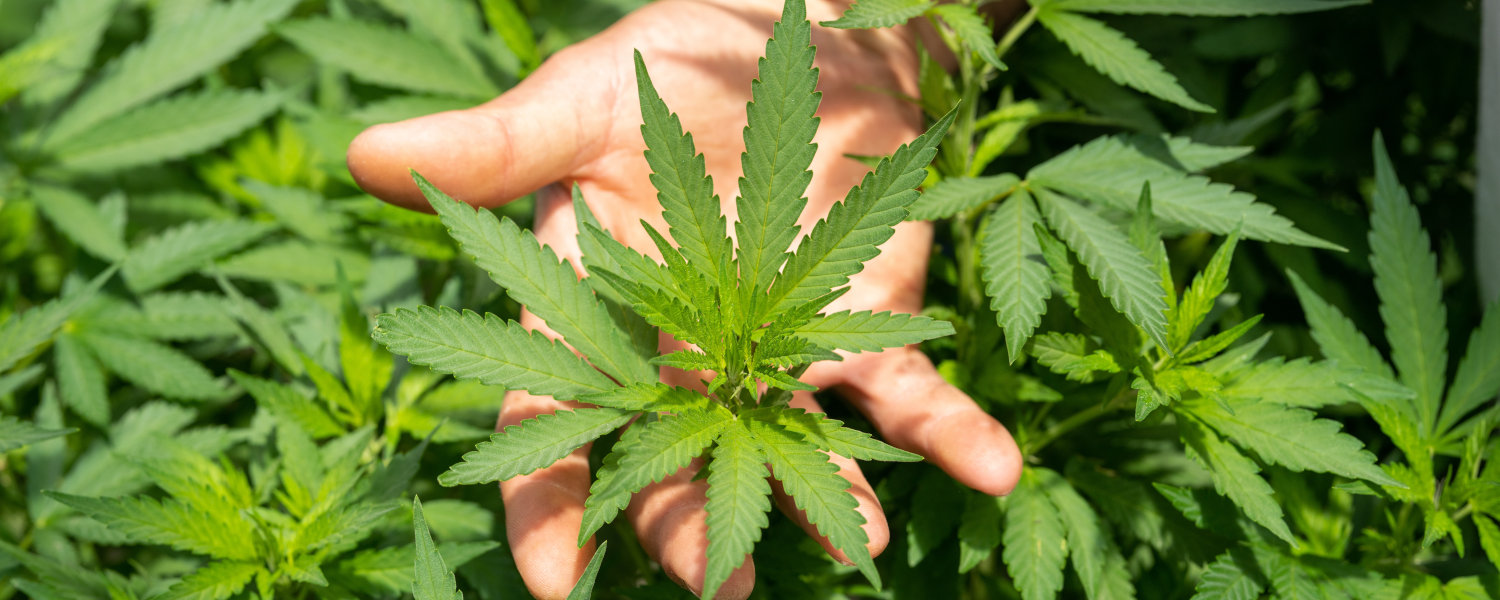Cannabis terminology can be overwhelming for beginners. Seemingly countless terpenes, cannabinoids, and strains can make it hard to find the right selection. And even the simple hybrid, sativa, and indica labels can be surprisingly confusing.
Cannabis plants were traditionally categorized as sativa or indica. However, decades of crossbreeding mean that most modern strains are actually hybrids, containing traits from both “indica” and “sativa” in varying ratios.
So, what is hybrid weed, and why does it matter to consumers?
What's Hybrid Weed?
Hybrid strains are the result of intentionally crossing the indica and afghanica cannabis varieties. Breeders carefully select these parent strains to produce offspring that inherit desired qualities from each.1 This allows breeders to create strains with specific THC or CBD content, terpene profiles, and growth characteristics.
Cannabis cultivation has a long history, but the rise of hybrid strains is a relatively recent phenomenon. It wasn’t until the 1980s that the terms "indica" and "sativa" became widespread terms based on the plants' geographical origin and growth patterns. Indicas, botanically classified as Cannabis sativa subsp indica var afghanica, tend to be short and produce denser flowers, while sativas, botanically classified as Cannabis sativa subsp indica var indica, are typically taller and have less dense flowers.2
However, breeders began experimenting with crossbreeding these distinct varieties in the 1970s. This innovation led to the creation of the first modern hybrid strain, Skunk No. 1. This breakthrough opened the door to a whole new world of cannabis experiences. Breeders could now combine the traits of indica variety plants with afghanica variety plants, focusing on desired traits like aroma, flavor, effect, and chemical profile.
Today, hybrid strains dominate the cannabis market, offering a vast array of effects and characteristics for growers and consumers alike. Hybrid strains can vary widely in their characteristics, depending on the specific ratio of the cannabinoids and terpenes they inherit. However, hybrids may often share some general characteristics:
- Effects: Hybrids may produce a balance of “indica” and “sativa” effects, offering a combination of relaxation and mental focus. Depending on the dominant parent strain, hybrids may exhibit effects that are more physical or mental.
- Growth: Hybrids may exhibit a growth pattern that falls somewhere between indica and sativa.
- Yields: Hybrids are often known for their high yields, making them a favorite among many professional and at-home growers.
Popular hybrid cultivars originating from landrace strains include Amnesia Haze, Blueberry, California Sour, and Northern Lights #5.3
Advantages of Hybrid Weed

- Specific Effects: Through careful breeding, hybrids possess a diverse array of cannabinoids and terpenes, potentially resulting in effects such as relaxation, euphoria, pain relief, or focus enhancement.
- Enhanced Genetics: Hybrids are meticulously bred to combine the desirable traits of their parent strains, resulting in plants with robust genetics. These hybrids often exhibit increased resilience to environmental stressors, making them suitable for cultivation in various climates and conditions.
- Medical Versatility: Hybrid strains are particularly sought after for their potential medical benefits. By crossbreeding different strains, breeders aim to create hybrids with specific cannabinoid and terpene profiles, catering to individuals managing various medical conditions such as chronic pain, anxiety, insomnia, or nausea. This versatility allows patients to choose cultivars that best address their symptoms and provide relief with less risk of unwanted side effects.
- Diverse Flavor Profiles: Another notable advantage of hybrid strains is their diverse flavor profiles, which result from the combination of distinct terpene profiles inherited from their parent strains. Whether it's fruity, earthy, gassy, citrusy, or spicy, hybrids offer a wide range of flavors and aromas that enhance the overall cannabis experience for consumers.
- Cultivation Flexibility: Hybrid strains are bred to optimize cultivation characteristics, which may make them suitable for both indoor and outdoor growing environments. Whether it is their adaptability to different lighting and nutrient regimens or their ability to resist common pests and diseases, hybrids may provide cultivators with flexibility and reliability in producing high-quality cannabis crops.
Drawbacks of Hybrid Weed
While hybrids are incredibly popular, you'll want to consider potential drawbacks to help you make the best choice for your needs, such as:
- Preference for Specific Effects: Some individuals prefer to sick to certain strains, but unfortunately, with the high number of hybrid strains flooding the market, pure landrace strains like Afghani Kush or Durban Poison can be hard to find.
- Oversaturation & "Trendy" Genetics: The popularity of hybrids has led to an overwhelming number of strains. It can be hard to know what's actually high-quality, especially as some breeders focus on creating the next popular dessert-themed name rather than emphasizing balanced effects or unique terpene profiles. Some cannabis enthusiasts feel certain strains (like Gelato and its many crosses) are overdone and lack distinctive qualities.
Why choose a pure strain over a hybrid?
There are a few potential reasons that someone would prefer a pure cannabis strain over a hybrid.
- Specific Needs: Looking for a targeted relaxation/sleep aid or a clear-headed, creative energy boost (though specific effects can be found in the right hybrid strain).
- Experience Level: Newcomers to cannabis might find it easier to understand the effects of a single strain type.
- Personal Preference: Some individuals simply prefer the distinct experiences landrace cultivars offer.
There’s no right or wrong between hybrid vs. pure strain. It’s important to find the right type of cannabis that best suits your individual needs and preferences.
Indica vs Sativa vs Hybrid

Strains labeled “indica” are typically associated with relaxing sedative effects and are ideal for evening use. On the other hand, strains labeled as “sativa” are thought to have energizing, uplifting effects and are better suited for daytime use. However, these labels aren't always accurate.
Decades of crossbreeding have blurred the lines between indica and sativa. Most modern strains are hybrids with varying degrees of indica or afghanica variety genetics. Likewise, scientists have found that the effects of a particular strain depend more on its unique chemical profile – its cannabinoids (THC, CBD, or others) and terpenes – rather than simply being labeled "indica" or "sativa."
Instead of focusing solely on indica, sativa, or hybrid labels, look at the following to better predict the effects of a strain:
- Lab test results: Check for the THC and CBD percentages and dominant terpenes to understand the type of experience you might have.
- Aroma: As many people in the industry will say, “The nose knows.” Studies and individual reports indicate that the aroma is more aligned with the subject effect of cannabis.4 If you have the opportunity to smell your flower before purchase, picking the strain that smells most appealing to you seems to be a great method.
- Dispensary descriptions: Reputable dispensaries offer detailed descriptions of their strains, including effects like relaxed, euphoric, creative, and more. However, these are usually based on how others feel and may not be a strong indicator of how you will feel using that strain.
A Better Way to Choose Strains
When it comes to selecting cannabis strains, the focus has historically been on broad labels, like indica, sativa, or hybrid. However, a more nuanced approach considers the intricate interplay between cannabinoids and terpenes. Terpenes, the aromatic compounds found in cannabis, play a significant role in shaping the plant's effects and therapeutic potential.
Terpene Combinations and Effects
Myrcene and Terpinolene:
- Effects: Myrcene, commonly found in indica strains, is associated with sedation and relaxation.5 Terpinolene, often prevalent in strains labeled as “sativa,” may offer uplifting and mood-enhancing effects.6
- Strains: Purple Haze, Tangie, and Fruity Pebbles OG.
Caryophyllene and Linalool:
- Effects: Caryophyllene exhibits anti-inflammatory properties, while linalool may provide a calming effect, making it ideal for stress relief.7,8
- Strains: Biscotti, Blue Cheese, Dosidos, Gelato, and Mimosa.
In addition to terpenes, THC and CBD cannabinoids play critical roles in the overall effects of cannabis. Choosing strains based on cannabinoid ratios can further personalize the experience.
- THC-Dominant Strains: These are often preferred for their euphoric and intoxicating effects, which may be suitable for managing pain and insomnia or enhancing creativity.
- CBD-Dominant Strains: Ideal for those seeking relief without the intoxicating high, CBD-dominant strains offer therapeutic benefits such as pain relief, anxiety reduction, and anti-inflammatory properties.
- High-THCV Strains: Strains high in THCV may contribute to metabolism and glucose levels and result in lower reports of the munchies, which may play a role in diabetes.9
The Entourage Effect
The entourage effect refers to the synergistic interaction between cannabinoids and terpenes, enhancing the overall therapeutic effects of cannabis. By selecting strains with diverse cannabinoid and terpene profiles, users can harness the full potential of this phenomenon.
Research suggests that certain combinations, such as THC with myrcene and caryophyllene, may amplify the therapeutic benefits while mitigating potential side effects.10,11
Tips for Buying Hybrid Weed

If you're planning to buy hybrid weed, there are several things you should keep in mind to make the most of its benefits and avoid potential risks.
- Define Your Goals: What are you looking for in a cannabis experience? Relaxation? Creativity? Pain relief? Understanding your desired effects is key when selecting a hybrid strain.
- Check Terpene Profiles & Cannabinoids: Pay close attention to the lab results – terpene percentages and dominant cannabinoids – available on the dispensary's website or product label. Terpenes will determine a lot of the flavor, aroma, and potential effects, so consider which ones best suit your preferences.
- Do Your Research: You can look up a strain's lineage. If you're familiar with the parent strains, you'll have a better idea of what effects to expect.
- Explore Reviews and Strain Descriptions: Don't rely on the indica/sativa label. Read product descriptions and independent reviews. You can refer to unbiased strain reviews to get an account of what you can expect.
- Avoid Strains with Unpleasant Aromas: Your nose is a powerful tool. If the smell is unappealing, chances are you won't enjoy the experience.
- Prioritize Reputable Sources: Buy from trusted dispensaries or brands with a commitment to quality and testing. Third-party lab reports ensure you know exactly what you're getting.
Buying cannabis is a personal process. Experiment, learn about your preferences, and most importantly, enjoy the journey of exploring the wide world of hybrid strains.
References
- Barcaccia G, Palumbo F, Scariolo F, Vannozzi A, Borin M, Bona S. Potentials and Challenges of Genomics for Breeding Cannabis Cultivars. Frontiers in Plant Science. 2020;11. doi:https://doi.org/10.3389/fpls.2020.573299 ↩︎
- McPartland JM, Small E. A classification of endangered high-THC cannabis (Cannabis sativa subsp. indica) domesticates and their wild relatives. PhytoKeys. 2020;144:81-112. Published 2020 Apr 3. doi:10.3897/phytokeys.144.46700 ↩︎
- Rahn B, Pearson BJ, Trigiano RN, Gray DJ. The Derivation of Modern Cannabis Varieties. Critical Reviews in Plant Sciences. 2016;35(5-6):328-348. doi:https://doi.org/10.1080/07352689.2016.1273626 ↩︎
- Plumb J, Demirel S, Sackett JL, Russo EB, Wilson-Poe AR. The Nose Knows: Aroma, but Not THC Mediates the Subjective Effects of Smoked and Vaporized Cannabis Flower. Psychoactives. 2022; 1(2):70-86. https://doi.org/10.3390/psychoactives1020008 ↩︎
- Surendran S, Qassadi F, Surendran G, Lilley D, Heinrich M. Myrcene—What Are the Potential Health Benefits of This Flavouring and Aroma Agent? Frontiers in Nutrition. 2021;8. doi:https://doi.org/10.3389/fnut.2021.699666 ↩︎
- Lewis MA, Russo EB, Smith KM. Pharmacological Foundations of Cannabis Chemovars. Planta Medica. 2017;84(04):225-233. doi:10.1055/s-0043-122240 ↩︎
- Sommano SR, Chittasupho C, Ruksiriwanich W, Jantrawut P. The Cannabis Terpenes. Molecules. 2020;25(24):5792. Published 2020 Dec 8. doi:10.3390/molecules25245792 ↩︎
- Cui J, Li M, Wei Y, et al. Inhalation Aromatherapy via Brain-Targeted Nasal Delivery: Natural Volatiles or Essential Oils on Mood Disorders. Frontiers in Pharmacology. 2022;13. doi:https://doi.org/10.3389/fphar.2022.860043 ↩︎
- Abioye A, Ayodele O, Marinkovic A, Patidar R, Akinwekomi A, Sanyaolu A. Δ9-Tetrahydrocannabivarin (THCV): a commentary on potential therapeutic benefit for the management of obesity and diabetes. J Cannabis Res. 2020;2(1):6. Published 2020 Jan 31. doi:10.1186/s42238-020-0016-7 ↩︎
- Baron EP. Medicinal Properties of Cannabinoids, Terpenes, and Flavonoids in Cannabis, and Benefits in Migraine, Headache, and Pain: An Update on Current Evidence and Cannabis Science. Headache: The Journal of Head and Face Pain. 2018;58(7):1139-1186. doi:https://doi.org/10.1111/head.13345 ↩︎
- erber SG, Namdar D, Hen-Shoval D, et al. The "Entourage Effect": Terpenes Coupled with Cannabinoids for the Treatment of Mood Disorders and Anxiety Disorders. Curr Neuropharmacol. 2020;18(2):87-96. doi:10.2174/1570159X17666190903103923 ↩︎
The information in this article and any included images or charts are for educational purposes only. This information is neither a substitute for, nor does it replace, professional legal advice or medical advice, diagnosis, or treatment. If you have any concerns or questions about laws, regulations, or your health, you should always consult with an attorney, physician or other licensed professional.




